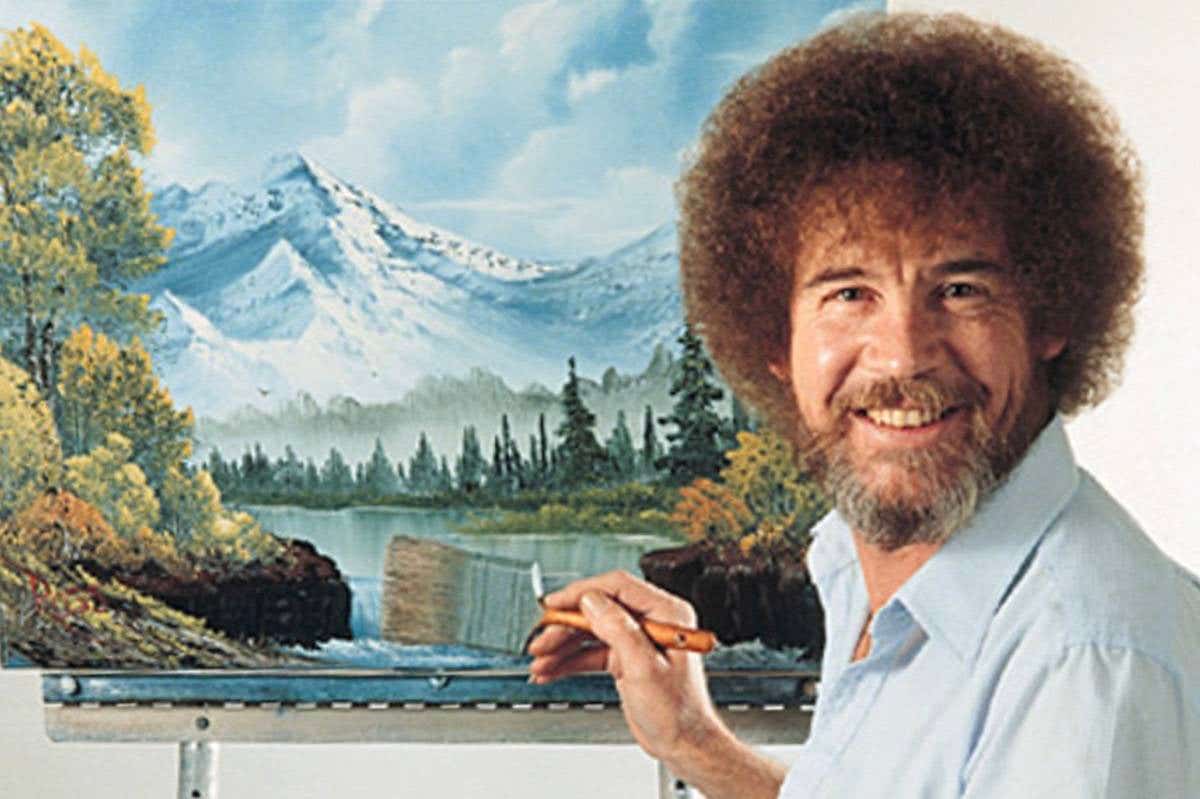Why Is Bob Ross Still So Popular?
[July 29, 2020: The Atlantic] Twenty-five years after his death, the painter who gave us “happy little trees” is more ubiquitous than…

[July 29, 2020: The Atlantic]
Twenty-five years after his death, the painter who gave us “happy little trees” is more ubiquitous than ever.
“”
Staring at the empty canvas on the easel in front of me, I couldn’t understand how this—nothing—might somehow transform into even a rough approximation of the Bob Ross painting we were using as a model. That painting was classic Bob Ross: a snowy landscape bursting with color, a world of glimmering trees and vibrant shrubs around a slick icy pond. Gazing at it evoked that feeling you get sitting by a fire on a crisp, cold night. No way I could make anything like that.
I was in a room on the side of a big-box craft store in the suburbs north of Dallas, about to start a class taught by John Fowler, a Bob Ross–certified instructor—which means that he spent three weeks in Florida learning the wet-on-wet painting technique Ross employed on television. A tall, bespectacled man in his 60s, with a light beard and a deep voice and soothing cadence reminiscent of Ross himself, John explained that he has a few things in common with the puffy-haired painter. They both spent many years in the Air Force, for example, and both retired with the rank of master sergeant. I’d learn he also uses some Bob Ross vernacular, sprinkling instructions with expressions like “We don’t make mistakes, we just have happy accidents.”
Like these kind of stories? Get The Brighter Side of News' newsletter.
John watched Bob Ross on The Joy of Painting for years, both during the show’s original run in the 1980s and ’90s, then later by streaming it. Four years ago, John decided to get some paint and a canvas and try painting along with the host. He liked it so much that he took some lessons. Then he liked those so much he paid about $400, not including supplies or lodging, and signed up for the official “Certified Ross Instructor” class, taught by Bob Ross Inc. trainers. When we met, John was wearing a black T-shirt with the painter’s face on it.
If you’re somehow not familiar with the name, Bob Ross is probably America’s most famous painter. With his distinctive hair, gentle voice, and signature expressions like “happy little trees,” he’s an enduring icon. Even 25 years after his death, he’s popular not only with viewers who remember him fondly, but also with kids who weren’t even born when his show was originally on the air.
Bob Ross Inc. is still thriving. The company owns hundreds of highly sought after Bob Ross originals. (It’s almost impossible to find one of his paintings for sale.) The official Bob Ross YouTube channel, run by the company, has over 4 million subscribers and more than 360 million total views. His likeness appears on a wide assortment of objects: paints and brushes, toasters, socks, calendars, dolls, ornaments, and even a Chia Pet—the plant grows in the shape of his famous hair. There are branded games and Pez dispensers and a children’s book. Every Halloween, thousands of Americans don curly-haired wigs and carry paint palettes and attend parties as Ross. As the coronavirus pandemic has spread and the world has gone inside, tens of millions of people have turned to old Joy of Painting episodes.
Bob Ross is the ultimate calming presence.
I wanted to understand his magical draw. I wanted to understand what it is about this man, and this show, that appeals to so many people across space and time.
That’s how I ended up at the craft store, about to paint a picture for the first time since I was in elementary school. Like John, I’ve watched Bob Ross for years. Unlike John, I’ve never tried painting along. I’ve always been content to watch and listen as the painter whisks out a serene portrait of nature in just under half an hour. But maybe, by actually using his technique, I could learn something else. Maybe by emulating Bob Ross, I could better understand Bob Ross.
John laid out nine gobs of paint, each a different color, in a semicircle on some butcher paper next to my easel. This was to be my palette. I recognized the names of the colors from hearing Ross say them on the show: Alizarin Crimson, Van Dyke Brown, Yellow Ochre. John explained how to spread the paint out and tap it onto the end of the brush’s bristles.
Then it came time for the first strokes of paint on the canvas: some bright orange figure-eight marks to represent the sun on what would be the horizon. John demonstrated on his own canvas a few feet away, then I tried my best to mimic what he was doing. Seeing the color slowly spread across my canvas was both exhilarating and terrifying. Mine was also a little clumpy at first.... MORE



